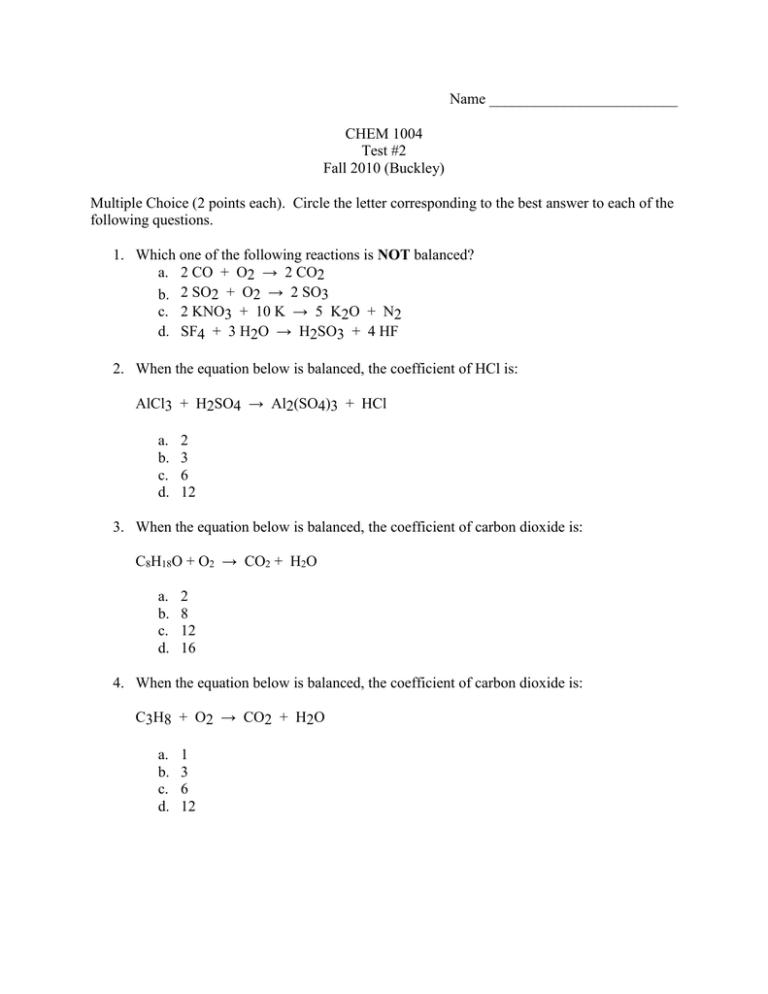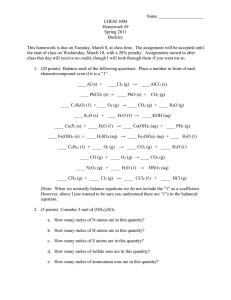Name _________________________ CHEM 1004 Test #2
advertisement

Name _________________________ CHEM 1004 Test #2 Fall 2010 (Buckley) Multiple Choice (2 points each). Circle the letter corresponding to the best answer to each of the following questions. 1. Which one of the following reactions is NOT balanced? a. 2 CO + O2 → 2 CO2 b. 2 SO2 + O2 → 2 SO3 c. 2 KNO3 + 10 K → 5 K2O + N2 d. SF4 + 3 H2O → H2SO3 + 4 HF 2. When the equation below is balanced, the coefficient of HCl is: AlCl3 + H2SO4 → Al2(SO4)3 + HCl a. b. c. d. 2 3 6 12 3. When the equation below is balanced, the coefficient of carbon dioxide is: C8H18O + O2 → CO2 + H2O a. b. c. d. 2 8 12 16 4. When the equation below is balanced, the coefficient of carbon dioxide is: C3H8 + O2 → CO2 + H2O a. b. c. d. 1 3 6 12 5. When the equation below is balanced, the coefficient of zinc is: Zn + CuSO4 → ZnSO4 + Cu a. b. c. d. 0 1 2 3 6. Avogadro's number is a. 6.02 × 1023 b. 6.02 × 10-23 c. 3.02 × 1026 32 d. 2.03 × 10 7. Which of the following has the same number of atoms as 23 g of sodium? a. 23 g of potassium b. 19 g of potassium c. 24 g of magnesium d. 18 g of water 8. Which of the following does NOT contain Avogadro's number of particles? a. 1.0 mole of carbon b. 23 g of sodium c. 6.02 × 1023 atoms of silicon d. 12 g of water 9. Which of the following contains Avogadro's number of atoms? a. 15.5 g of phosphorus b. 39 g of potassium c. 40 g of bromine d. 100 g of mercury 10. How many moles of sulfur atoms are present in 3.00 moles of CS2? a. 1.00 b. 3.00 c. 6.00 d. 9.00 11. In the reaction CH4 + 2 O2 → CO2 + 2 H2O how many moles of oxygen are required to burn 16.0 g of methane? a. 0.50 b. 1.0 c. 2.0 d. 32 12. A one molar solution is a solution that contains one mole of solute in a. one mole of solvent. b. one liter of solution. c. one kilogram of solvent. d. one kilogram of solution. 13. Which state of matter is characterized by having molecules far apart and moving randomly? a. gas b. liquid c. solid d. all of these 14. The temperature at which a solid becomes a liquid is called the a. melting point. b. boiling point. c. condensation point. d. decomposition point. 15. The temperature at which a solid melts is the melting point of the solid. The melting point is an indication of the intermolecular forces that hold the solid together. Water melts at 0°C. Table sugar (sucrose) melts at 285°C. Gallium, Ga, melts at 30°C. Which one of the following ranks the intermolecular forces in these solids from the strongest to the weakest? a. Ga > water > sucrose b. sucrose > Ga > water c. water > sucrose > Ga d. Ga > sucrose > water 16. For which of the following is hydrogen bonding NOT a factor? a. H2O b. NH3 c. CH4 d. CH3OH 17. An ideal gas is confined in a piston. The volume of the gas is cut to one-third of its initial value while the temperature remains the same. The pressure of the gas: a. b. c. d. e. will remain the same will triple will be cut in one-third will be increased nine-fold there is not sufficient information to answer the question 18. The temperature of a gas is doubled and its volume is cut in half. The pressure of the gas a. b. c. d. e. will be cut in one-half will be cut in one-fourth will be doubled will be four times larger will be one-fourth of its original value 19. Which of the following is NOT a postulate of the kinetic-molecular theory? a. Molecules of a gas move rapidly and in straight lines. b. The molecules in a gas are tiny compared to the distance between them. c. The molecules of a gas are strongly attracted to each other. d. If two molecules collide with each other, the total energy of the molecules before the collision is the same as their total energy after the collision. 20. Consider two samples of different ideal gases both at the same temperature, pressure, and volume. Which of the following statements must be true of the two gases? a. they both contain the same number of moles of gas b. they both contain the same mass of gas c. they both contain the same number of atoms of gas d. they must contain a different number of molecules of gas Short answer. The point totals are indicated next to each problem number. Show your work to receive full credit for numerical problems. 21. (6 points) a. How many grams of NH3 are contained in 4.0-mol of NH3? b. How many mol of Cl atoms are contained in 10.0-mol of PCl5? c. Which contains more atoms of oxygen – 150 molecules of H2O or 10.0 g of CO2? (You probably shouldn’t have to calculate anything here – think about the sample sizes.) 22. (4 points) A gas sample is confined to a volume of 250.0-L at a temperature of 250 K and a pressure of 4.0-atm. If the volume is changed to 100.0-L, what temperature is required to achieve a final pressure of 6.0-atm? 23. (6 points) 2.5-mol of the gas carbon dioxide exert a pressure of 4.5 atmospheres in a volume of 50.0-L. What is the temperature of the gas? 24. (6 points) State the intermolecular forces –dispersion, dipole-dipole, and/or H-bonding present between molecules of each of the following species. a. CH4 b. CH3Cl c. CH2Cl2 Things I think I told you I would give you: PV nRT PV PV 1 1 2 2 T1 T2 R 0.08206 L atm mol K





